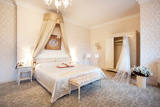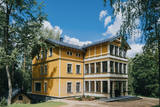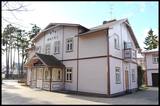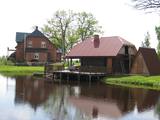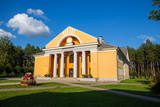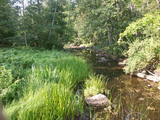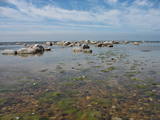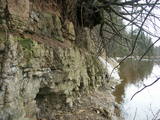| No | Name | Description |
|---|---|---|
|
The guest house is located near the Riga - Tallinn highway, near the Oltuži stop, 3.5 km from the beautiful Veczemju cliffs and the sea. The main building offers dormitory-style accommodation with 10 beds, shower, WC, seating area, refrigerator and washing machine. The sauna house has a sauna, facilities and a furnished kitchen corner. There are 2-3 beds on the 2nd floor of the house. The guest house also offers rooms for various celebrations: banquets, meetings, family events for up to 30 people. Catering is also available for events. Camps for young people up to 50 people can be organized in the area. |
||
|
If you have a desire to escape from the urban crowd and noise, to enjoy the sun and the sea, to get a breath of pine forest, to watch lamprey fishing in the river Svētupe to go out for picking up mushrooms, to ride a bicycle or go skiing, to be inspired by the Svetupe flood- Vējavas is located at the Svētupe`s fall into the Rīga Gulf, on the motorway Rīga – Tallinn 90th km, 10 km before Salacgrīva. |
||
|
The hotel "Port Hotel" is located in Adazi, on the edge of the Riga-Tallin road, in the pine forest environment. The hotel attracts attention with an interesting sailing ship design. In the restaurant you can enjoy a rich breakfast, fine lunch and dinner. The hotel also offers SPA services and organizes conferences, workshops and banquets. |
||
|
8km from Madona. Services for meetings up to 60 persons. Party rooms for 100 persons, in summer - outdoor terrace and a tent for up to 130 persons. Skiing slope and ski gear rent nearby. |
||
|
In Mālpils village, 18km from Sigulda town, a renovated estate building. The excellent Classicism style architectural monument and a history museum have been converted in a luxury hotel with 22 rooms and party facilities. 2 rooms for people with special needs. Baroque style park, scenery, romantic walks, fancy meals in the estate’s restaurant, a tea house, a playroom for kids.
|
||
|
A cottage with sauna on the banks of the Loja River, 5 km from Murjāņi. An outdoor tub with a fire place, swings, and slide for children.
|
||
|
In 2017, a design hotel was opened in Cesis, on the banks of the Gauja River. At the end of 19th century and at the beginning of 20th century Russian aristocrats built villas for summer recreation here. At present, six hectares of the territory are home to three villas (Villa Santa, Villa Ieva and Villa Carola) with a restaurant, a hall of TILTA HOUSE, an ancient apple garden and a restored wooden gazebo. The hotel has 30 rooms, with a light interior, with a touch of Scandinavian minimalism and Latvian bourgeoisie, preserving the aura of the summer cottage. |
||
|
A very simple hotel in Jūrmala. Café, banquet hall, bar, sauna, bubble bath. Holiday apartments. Price reductions in low season. Cheep and tasty meals. Parking lot. Food shop.
|
||
|
A quiet homestead 10km from Madona. A part of the house for guests’ use. A sitting room with a fireplace, a kitchen, 2 bedrooms and WC/shower facilities on the 1st floor. 3 DBL or twin bedrooms and a small sitting room on the 2nd floor. A sauna house by the ponds. Sauna expert and massage services on request. Fishing in the ponds or in the Aiviekste river.
|
||
|
The facility has been built in a billowy territory of 10 hectares. Half of the territory is occupied by fish ponds, amidst which stands the recreation center. At the recreation center, you will enjoy countryside silence. There is no agricultural activity in the territory. The recreation center Zemturi will suit the recreation needs of big and small alike. At the recreation center: |
||
|
The farm has a herd of 70 cows to produce milk, yogurt, cottage cheese, cream and cheese. It is open to shoppers every Friday. |
||
|
This is an area that is full of legend and tale. There is a stiff hillock, which stands about 66 metres above the surrounding land. From its southern side, you can see the Burtnieki lowlands. The tower, however, is not open to the public.
|
||
|
No 28 m augstā torņa, kas atrodas uz apdzīvotas „salas” – Siksalas Teiču purva vidū, paveras ļoti plaša augstā purva ainava ar Siksalas ezeru, citām minerālzemes salām un Siksalas mazciemu. Tā kā tornis atrodas Teiču dabas rezervātā, to var apmeklēt tikai Dabas aizsardzības pārvaldes inspektora pavadībā, iepriekš piesakot vizīti T: + 371 28333415. |
||
|
This is the most modern rabbit farm in the Baltic States. The animals live in cages in a shed, but there are also cages outside where they can be viewed. Children will love contacts with 24 types of rabbits, as well as an opportunity to study the surrounding area from a viewing tower. If you apply in advance, you can purchase fresh rabbit meat, sausages, dried meats and pâté. A new thing at the farm is the Mangalicas breed of wild pigs from Hungary. |
||
|
Seda is one of the most unusual towns in Latvia. It began its life as a housing area for people from the local peat moss factory, and that happened in the 1950s and 1960s. This is a “vivid” example of Soviet architecture, with a central square (complete with a monument to the Leader) and streets radiating from it. Worth a visit is the cultural centre at the end of Uzvaras Street. It is a great example of so-called Stalinist Classicism architecture. |
||
|
A distinct area of the lower reaches of the Vitrupe River, with small sandstone cliffs and many rare species of plants and molluscs. Visitors can visit the Ķirbiži Forest Museum and its information and botany trail. It weaves along both banks of the river and allows people to look at the most typical examples of flora in the region. The noble Vāloži oak tree is a key element there.
|
||
|
The watermill processes wool with equipment that is 100 years old and is used to produce handmade blankets and pillows that are stuffed with sheep wool, as well as souvenirs that can be commissioned and purchased. The watermill offers tours and fresh-baked bread. A wool pulling and wrapping machine that dates back to the 19th century and was manufactured at the Šūberts Rudītis & Co company in the 19th century is still used, as are a unique weaving apparatus from Germany and a grain mill.
Latvian cuisine: Marinated herring with vegetables, porridge, mashed potatoes a la Vidzeme (with fried onions), pancakes with jam made of Latvian berries and honey, homemade bread.
Special foods: Water pretzels and local soup with six types of fish.
|
||
|
Temple Hill is steep (with artificially created steepness) and about 30 m high, and it is opposite Marijas Island. It is an ancient Lettigalian castle hill, 80 m long and 40 m wide, with several artificial ramparts. One of the oldest objects found in the region is an axe from the 2nd to 3rd millennium BC. Archaeologists believe that the island was populated at that time. There was a Lettigalian castle on the hill during the 10th and 11th century, but it was sacked by the Holy Crusade. The surface of the castle hill was transformed comparatively recently in 1807, when a granite rotunda was built there in honour of Russian Field Marshall Sheremetev and Swedish captain Wulff. The view of Lake Alūksne and the town is one of the most beautiful ones in all Vidzeme. The Sun Bridge (1937) is also worth a look. A wooden viewing platform is nearby. |
||
|
This is an important territory for the protection of reefs. It is opposite the Salacgrīva Administrative District and covers 3,577 hectares. The marine part of the “Rocky Shore of Vidzeme” nature reserve is a part of the territory.
|
||
|
This is a unique geological object of paleontological importance. Up to four metres high, the cliff has yielded up fossils of ancient invertebrates and fish.
|
||




